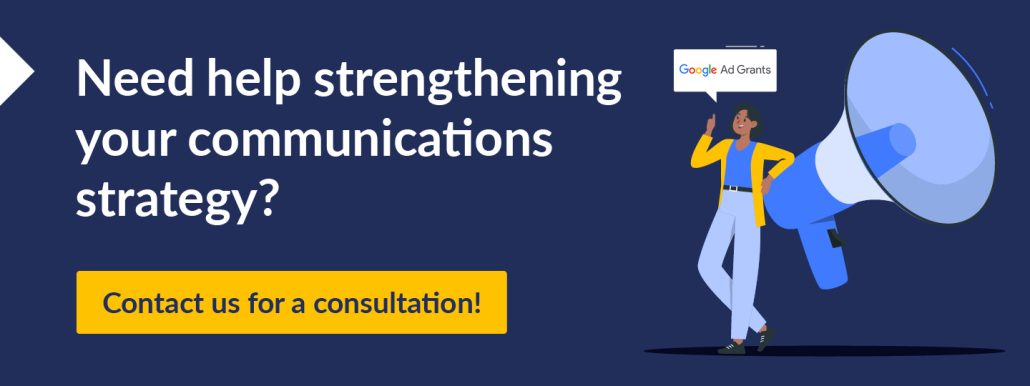Improve Your Nonprofit Communications Strategy in 5 Steps
Staying in touch with your supporters brings in donations, helps you find sales leads, recruits volunteers, and spreads awareness for your cause. Strong nonprofit communications are essential to earning all of these benefits.
Nonprofit communications refers to all the tactics a nonprofit implements to communicate with stakeholders and promote its cause. A full communication plan should address fundraising, events, mission, and more. The plan should lay out the media channels it will use, including social media, email, direct mail, and more.
- Nonprofit Communication Goals
- 4 Types of Nonprofit Communication
- Developing Your Nonprofit Communications Plan: 5 Steps
- 3 Helpful Nonprofit Communication Tools & Resources
At Getting Attention, we help nonprofits market to and communicate with supporters using the Google Ad Grants program. We empower nonprofits to leverage up to $10,000 in free monthly Google Ad credits to reach new supporters, engage current donors, and strengthen relationships. In this guide, we’ll explore how to leverage Google Ads and a variety of other marketing channels.
Nonprofit Communication Goals
Both for- and nonprofit organizations need strong external communication strategies to promote their brands and offerings to their target audiences. The difference between your nonprofit’s strategy, a business’s, and another nonprofit’s is your goals.
Your goals dictate your marketing and communication strategy. A few common goals nonprofits have include:
- Earning donations. Fundraising powers many nonprofits. As you are likely not giving supporters anything in exchange for their gifts, your marketing materials should emphasize the non-material benefits of donating, such as the opportunity to make an impact.
- Selling products and services. Nonprofits that sell products and services can follow many strategies commercial businesses use to promote their offerings. Consider what needs your audience has, how your services fill that need, and why customers should buy from your organization specifically. Your marketing materials should address these three factors.
- Recruiting volunteers. Most nonprofits operate on tight budgets, and volunteers put in the work your nonprofit needs to continue running. When crafting recruitment outreach, consider what types of jobs volunteers want to do, how the volunteer positions benefit the volunteers, and how the volunteer work makes a difference for your mission.
- Spreading awareness. The more people that know and care about your cause, the more change you’ll drive. Awareness communication materials should grab as much attention as possible, whether it’s through startling statistics, eye-catching imagery, or a highly shareable story.
- Reaching beneficiaries. If your nonprofit has the capacity to serve more beneficiaries than it already does, make spreading the word about your services one of your top priorities. Similar to paid products and services, explain what your nonprofit does, how it benefits your constituents, and why they should let your nonprofit help them.
Your goals impact every part of your communication strategy from the contents of your communication materials to the platforms you share them on on. Additionally, your goals impact the type of communication materials you’re likely to produce.
4 Types of Nonprofit Communication
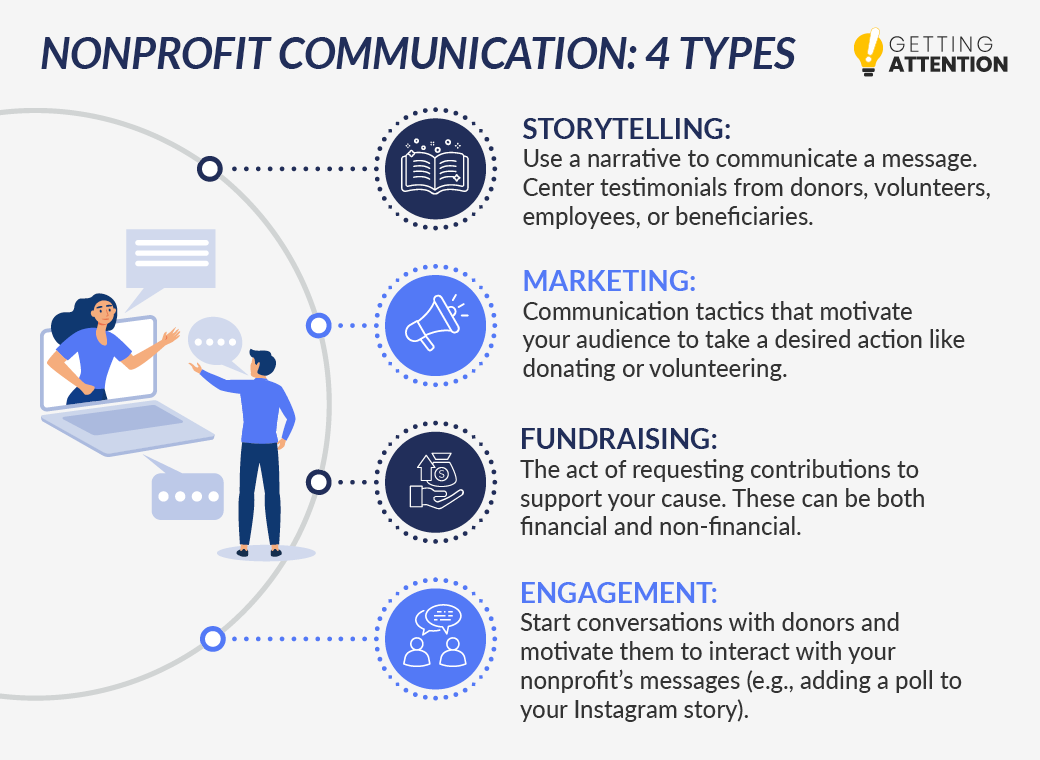
1. Storytelling
Storytelling makes your communications more effective, engaging, and emotional. Studies show that 55% of consumers are more likely to remember a story rather than a list of facts, meaning storytelling can help your nonprofit get its mission across in a memorable way.
These examples show how nonprofits can share powerful stories:
- A university could share quotes from both current and former students about what the school means to them and how their time as a student impacted them.
- Animal shelters can ask people who have adopted a pet from their shelter about the difference their pet has made in their lives.
- Food banks could talk to volunteers about the work they do and what it means to them to give back.
Don’t forget to be creative and dig deep to find the most compelling stories. Prioritize quality writing, and incorporate powerful images and videos when possible.
2. Marketing
Marketing describes nonprofit communication tactics that have the goal of motivating target audiences to take action. Some of the next actions you might encourage your audience to take include:
- Making a donation
- Buying your products or services
- Registering to volunteer
- Signing up for your newsletter
- Purchasing your branded merchandise
- Becoming a monthly donor
- Claiming a ticket to an event
Ultimately, your marketing efforts should articulate your nonprofit’s value proposition. A value proposition explains how your organization solves your audience’s needs, the benefits they receive from your organization, and how your organization is unique from the competition.
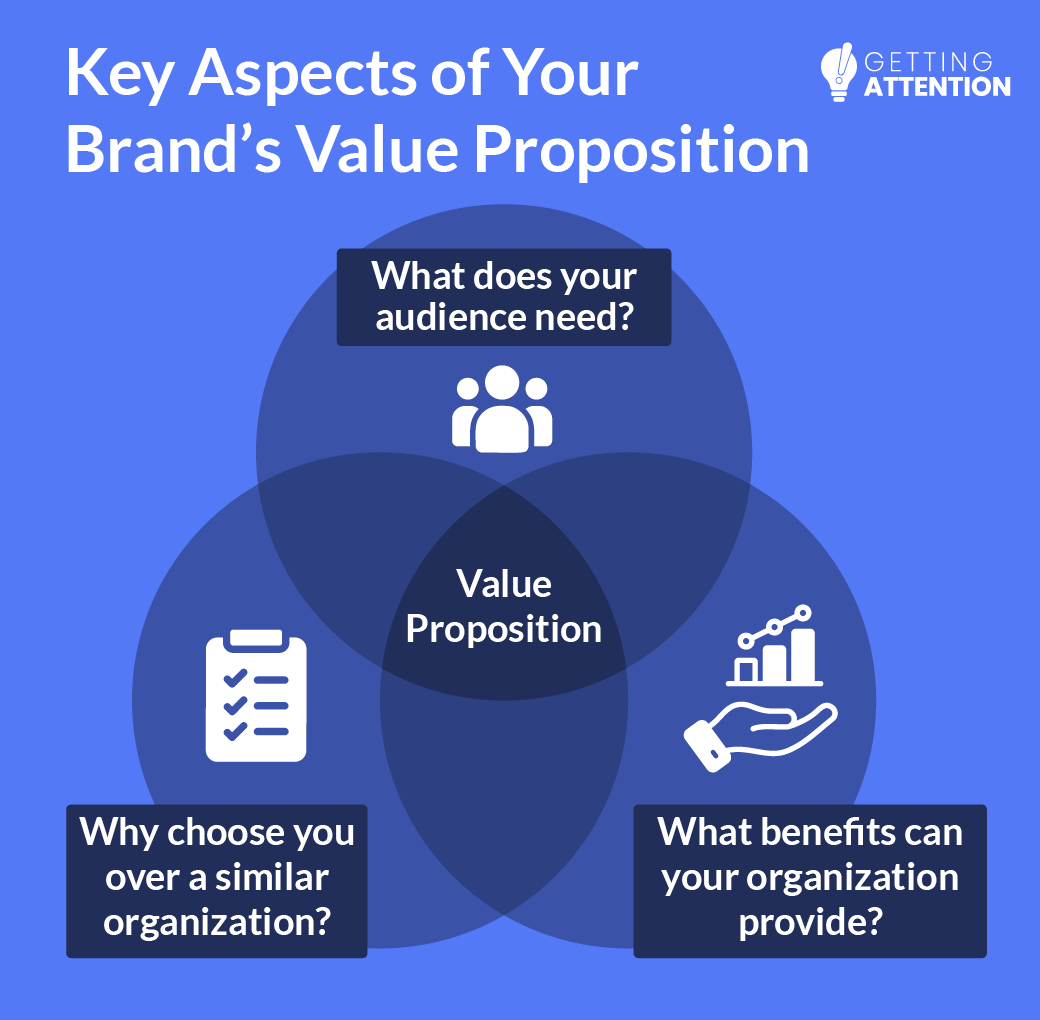
For example, let’s look at the nonprofit Wonder Ink. Wonder Ink sells children’s ministry curriculum to Sunday Schools, church leaders, and parents. Their value proposition might look something like this:
- Audience needs: Wonder Ink’s audience wants to engage children in religious studies but lacks the time and resources to create appropriate course materials themselves.
- Benefits received: Buyers get child-friendly course materials they can use to teach children about their religion.
- How Wonder Ink stands out: Wonder Ink’s materials can be accessed online, making them one of the most accessible and easy-to-use church curriculum services available.
When you want your audience to take a specific action, consider the value proposition behind it. Consider what your audience needs related to the action, the benefits they will gain by taking it, and why they should choose to engage with your nonprofit instead of a similar organization.
3. Fundraising
Communicating about your fundraisers can be complex, as it requires contact with a variety of audiences across many different communication channels. Your organization will need to tailor its outreach to your audience’s preferences and unique traits.
While you can get as granular as you like with personalizing communications to recipients, here are the three basic audiences you’ll address:
- Current Donors: Receiving a donation is great, and retaining that support over time is critical. After all, it costs less to retain an existing donor than it does to gain a new one. Be sure to maintain consistent communication with current donors (ideally across more than one communication channel) to boost the chances that they’ll give again.
- Potential Donors: To expand your supporter base, grow funding, and increase your volunteering capacity, you’ll need to reach new donors who have never engaged with your cause. It can be tricky to build trust with donors who have never heard of your organization before. However, you can build social proof by centering testimonials from other donors or publicly recognizing influential donors.
- Corporations: Did you know corporations donated $21.08 billion to nonprofits in 2022? Use this giving power to your advantage by directing fundraising communication efforts toward for-profit businesses. Spread awareness of the many different philanthropic programs, such as matching gifts, with your audience.
Even after a successful fundraising campaign, communication is still relevant. Check out this guide from eCardWidget to learn how your organization can upgrade its donor thank-you emails.
4. Engagement
This type of communication relies on starting conversations with your audiences. Engagement builds a relationship with your audience beyond simply asking them for money. Cultivating connection with stakeholders that exists separate from monetary goals is key to fostering deep, trusting relationships that yield long-term donors.
There are so many ways to motivate donors to engage, from adding a “click here!” button to a marketing email to feature polls on your nonprofit’s Instagram stories. Get creative, make engaging convenient, and be sure to offer a variety of ways to engage.
Developing Your Nonprofit Communication Plan: 5 Steps
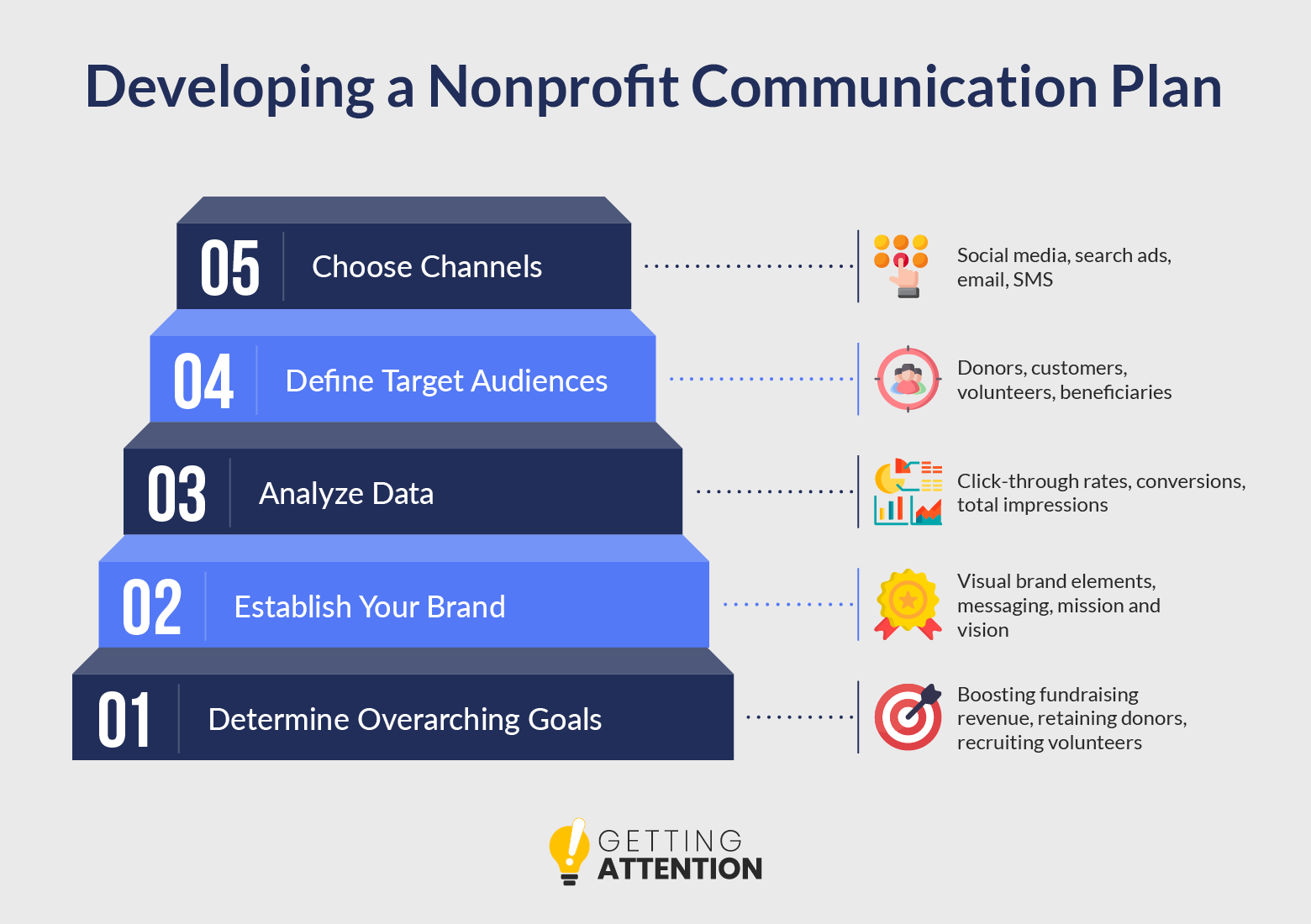
1. Determine Overarching Goals
A communication plan is a set of strategies developed for your nonprofit’s unique needs and goals. Its purpose is to reach and engage supporters. The first step to creating an effective communication plan is careful goal setting.
Define your goals according to the SMART goals framework. This method suggests that goals should be:
- Specific
- Measurable
- Achievable
- Relevant
- Time-bound
By setting goals within these parameters, you’ll ensure that each objective is attainable within your campaign timeline. An example of a SMART goal could be to earn 20% more sales leads through organic search traffic within six months of starting an intensive SEO strategy.
2. Establish Your Brand
Many aspects of your nonprofit communication tactics will be tailored to fit each audience, but your brand messaging should remain consistent across all efforts.
To keep branding consistent in communications, include your nonprofit’s:
- Name
- Logo
- Tagline (also called a slogan by for-profit businesses)
- Visual branded elements like specific colors, fonts, and imagery
To ensure these elements remain consistent no matter who creates or posts content at your nonprofit, create a media or branding kit. Include the appropriate use cases and image files for your logo, the Hex codes for your brand colors, and the names of the fonts you use.
Here’s our example of a nonprofit branding kit:
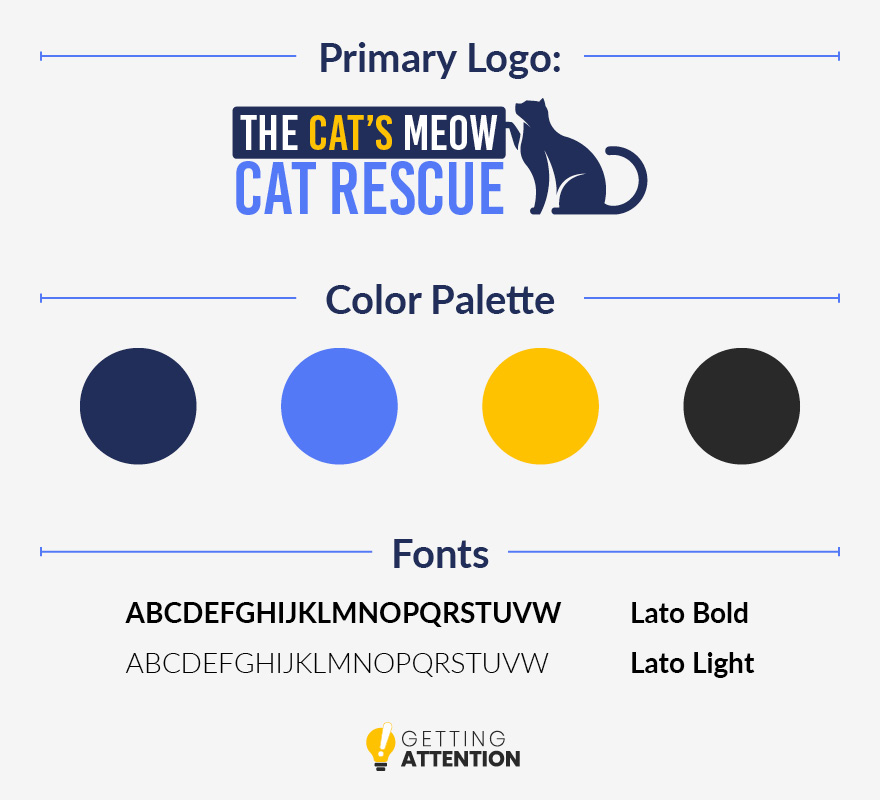
3. Analyze Data
Your communication strategy should always be backed by data. Without it, you could be making guesses about your audience that aren’t true, leaving you without the positive results you were hoping for.
Take a look at data from your nonprofit’s past communication efforts. What was successful, and what could be better? Use what you learn to refine future plans and understand trends. For example, maybe you noticed that donations to your food pantry spike around holidays like Thanksgiving. To capitalize on this increased engagement, ramp up the frequency of your communications and aim to reach untapped audiences.
4. Define Target Audiences
Your nonprofit likely has multiple audiences, each with its own needs and communication preferences. Defining target audiences becomes a lot easier with the help of a robust donor database. You can keep track of demographics, contact information, employer data, income, and location all in one place. You can also look at past donation data to figure out who your biggest supporters are.
In addition to donors, also consider the following audiences:
- Customers. The data you collect on customers has a lot in common with your donor data. You need basic demographic information as well as spending budgets. Assess your current customer base to identify trends, such as careers, locations, and budgets.
- Volunteers. In most cases, volunteers will be local supporters. Consider what skills you need from volunteers and how you can get in touch with these skilled volunteers, whether it’s through marketing, business partnerships, or networking.
- Beneficiaries. Consider who your cause helps, the benefits you can provide them, and the barriers they have preventing them from getting help. For example, a mental health-oriented nonprofit might provide free counseling services to low-income individuals. They’ve identified that unhoused individuals are a target beneficiary demographic but may struggle to access their services due to lack of information and a fear of being judged. The nonprofit could overcome these barriers by posting flyers and emphasizing their organization’s adherence to confidentiality.
Data analytics can help you avoid guessing about your various audiences and build communication strategies that appeal to their real motivations for giving to your cause.
5. Choose Channels
There’s a wide range of communication channels to choose from, and each channel you choose to communicate on requires its own strategy, marketing materials, and posting schedule. As such, you should be deliberate about the channels you choose and pick platforms that align with your goals.
Let’s walk through a few examples of how various communication channels can help achieve different nonprofit goals.
Goal: Sell products and services
Nonprofits selling a product or service need channels that will connect them with customers and continually generate revenue. As such, these organizations might heavily invest in driving organic traffic to their website through search engine optimization (SEO).
Through keyword research, these nonprofits can identify what their target audience is likely looking for. Using this information, they can create high-value content that answers their audiences’ questions, showcases their services and products, and demonstrates their expertise.
For example, the Nonprofit Leadership Alliance (NLA) sells courses to nonprofit professionals looking to improve their fundraising and nonprofit management skills Their SEO strategy targets keywords related to skill development, and users who click on their blog pages will find content providing free advice. These blog posts promote the NLA’s offerings and show off their expertise. Visitors who engage with and are impressed by this content may go on to explore the rest of NLA’s site and potentially purchase a full course or attend an event.
Thanks to the SEO experts at Nexus Marketing, the NLA achieved first page rankings for 32 high-priority keywords.
Goal: Attract volunteers
To reach volunteers, you need to think about channels that will reach a local audience. After all, while some volunteers can work remotely, most nonprofit initiatives and fundraisers require volunteers to be nearby.
For digital marketing, try Google Ads. Turn on Google Ads’ geo-locating parameters and share your nonprofit’s address with Google to ensure your ads are shown only to locals. Plus, rather than spending your limited budget on search engine ads, you can create Google Ads for free with the Google Ad Grant.
The Google Ad Grant awards qualifying nonprofits with $10,000 a month in ad credits to create Google Ads promoting their website.
For volunteer recruitment, nonprofits might launch a Google Ads campaign targeting keywords like “[type of nonprofit] volunteer opportunities” or “volunteering in [city].” These keywords help narrow down who your ads will be shown to, increasing the number of high-quality leads you’ll receive.
If you need help applying for the Google Ad Grant, managing your ads, or reactivating your account, our team at Getting Attention can help! As a Google-certified agency, we’re on top of the latest developments at Google and can help our clients create ads that reach their target audience, make the most of their budget, and always comply with Google’s requirements.
Goal: Spread awareness
Getting more eyes on your cause can lead to real change as more people lend their time, effort, and voices to support you. As such, nonprofits launching awareness campaigns should turn to platforms that have large audiences, like social media.
The power of social media is that passionate supporters can help market for you. Choose channels that encourage sharing and commenting. Be aware that some platforms with low conversion rates have high share rates and decide if that trade-off is worthwhile. If you’re fundraising or selling a service, you may want to prioritize platforms like Facebook and Instagram, whereas if you simply want as big of an audience as possible to see your message, you might turn to TikTok.
Additionally, consider what types of content are likely to be shared. Research into the psychology behind social media suggests that stories that provoke excitement—whether it’s positive or negative—tend to see the most shares. For nonprofits, this means telling stories that evoke emotions like joy or outreach lead to action.
3 Helpful Nonprofit Communication Tools & Resources
Once your nonprofit has a communications plan in place, it’s time to execute. But, it can be challenging (and time-consuming) to manage an entire communications strategy on your own.
To make the process easier, here are a few popular tools and resources to check out:
- Content calendars: Plan out your content for the entire month, including the type of content, the platform it will be posted on, when the content will go live, and what message will be included. Not only will this keep everything organized, but it will also help you plan accordingly to ensure each message is created on time. To get started, you can download a free template or invest in dedicated project management software.
- Graphic design tools: Sleek graphics and crystal-clear photos are what get you noticed in the digital world. You can easily design custom graphics for your nonprofit (or adapt templates to fit your branding) with tools like Canva. If you need additional support, consider working with a graphic design agency.
- Google Ad Grants: This program is a great resource for qualifying nonprofits. The grant provides $10,000 in free Google Ads, allowing your nonprofit to target relevant keywords and drive Google users to your website. For the best results, work with a Google Ad Grants agency to help you apply for the grant, maintain compliance, research keywords, and manage campaigns.
To learn more, check out our video that covers the basics of the Google Ad Grants program:
Wrapping Up
Compelling communication is vital to running a successful nonprofit organization. By building connections with target audiences, you’ll cultivate trusting, loyal relationships with donors that help further your mission. To reach more of these audience members and make your marketing budget go further with the Google Ad Grants program, reach out to Getting Attention.
For additional helpful information on crafting a nonprofit marketing strategy, check out these additional resources:
- Getting Started with YouTube for Nonprofits in 3 Steps. If you’re interested in leveraging video marketing, check out our guide to getting started.
- Nonprofit Marketing: A Behind-the-Scenes Guide for Success. Looking for an in-depth guide to marketing for nonprofits? Read on to learn more about furthering your mission through effective marketing.
- Charity Marketing: How to Spread Your Nonprofit’s Message. This step-by-step guide lays out the tasks your organization will need to complete in order to launch a successful charity marketing campaign.


